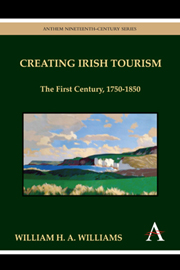Book contents
- Frontmatter
- Contents
- Preface
- Introduction
- Part I
- Part II
- Chapter 4 The Sublime and the Picturesque in the Irish Landscape
- Chapter 5 Picturesque Tourist Sites in Ireland
- Chapter 6 The Tourist Experience
- Chapter 7 Killarney—A Case Study of the Irish Tourist Experience
- Part III
- Conclusion
- Notes
- Bibliography
- Index
Chapter 5 - Picturesque Tourist Sites in Ireland
from Part II
Published online by Cambridge University Press: 05 March 2012
- Frontmatter
- Contents
- Preface
- Introduction
- Part I
- Part II
- Chapter 4 The Sublime and the Picturesque in the Irish Landscape
- Chapter 5 Picturesque Tourist Sites in Ireland
- Chapter 6 The Tourist Experience
- Chapter 7 Killarney—A Case Study of the Irish Tourist Experience
- Part III
- Conclusion
- Notes
- Bibliography
- Index
Summary
Marking Tourists Sites
As tourism develops, it reconfigures the host country into a succession of specific sites that shape the visitors' itinerary. In Britain, as Esther Moir points out, newly awakened curiosity sent early tourists off to explore as much of their country as was accessible. However once the great estates became organized for visitors, as ruins, mountains and lakes were “discovered” and noted in guidebooks, tourism came to define itself as a progress from one designated site to another. The same was true of Ireland.
What constitutes a tourist attraction? Dean MacCannell maintains that “no naturalistic definition of a tourist sight is possible.” Instead, it is the result of “an empirical relationship between a tourist, a sight, and a marker….” A marker “points” to a place. It can be any piece of information about a site, including travel accounts, guidebooks, the guides themselves, souvenirs and pictures. John Hutchinson suggests that engravings of scenes in Wicklow, which began to appear as early as 1730s, contributed to the popularity of certain tourist sites in that county. Literary associations also can act as markers. For instance, the ruins of Kilcolman Castle in County Cork, no more picturesque than those of many other abandoned Irish tower houses, could boast as its marker its connection to Edmund Spencer, author of The Faerie Queen.
Marking also facilitates the organization of a site or sight for visitors, not only physically in terms of accessibility, but conceptually as well.
- Type
- Chapter
- Information
- Creating Irish TourismThe First Century, 1750–1850, pp. 89 - 106Publisher: Anthem PressPrint publication year: 2010



